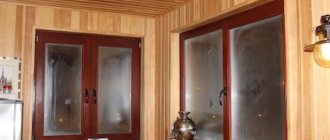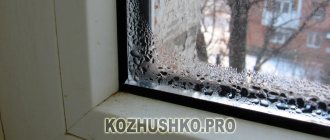Since this type of product is made with double-glazed windows that have several chambers, such windows are prone to fogging.
To get rid of the problem, it is recommended that you become more familiar with the means that eliminate condensation, and also find out what substances and recipes will help eliminate fogging of window products.
What makes glass sweat?
Leaks on windows in your home can be caused by several reasons.
For example:
- Increased humidity in the room and poor air circulation. Condensation especially accumulates on glass in the kitchen or bathroom due to frequent cooking and hanging laundry.
- There is a big difference between the temperature outside the house and inside.
- Insufficient circulation of warm flows from radiators and heating devices when it is wet outside and damp in the room.
- Wide window sill. Air from the radiator cannot get to the window, and an unheated zone remains in its lower section.
- Violations in window installation. To prevent windows from sweating, you should choose trusted manufacturers and high-quality materials. When saving on double-glazed windows or on installation services, work may not be performed according to standards with sealing violations. When the frame is skewed, the fit of the sashes is damaged.
- Lack of transom regulation. When installing, it is important to focus on the quality of regulation of the window sashes.
- Damage to the structure of the rubber seal. Depending on temperature and time, the material can harden and crumble, which leads to seal failure.
- Clogged drainage holes located under the opening flap. Water flows through the drains from the outside of the window during ventilation; if clogged, excess moisture will penetrate onto the window sill.
Increased dampness renders window fittings and household items unusable. Condensation is the main reason for the formation of fungus on slopes and window sills, which negatively affects the functions of the human respiratory system.
Features of plastic construction
To understand the reasons why condensation may appear on the glass, it is worth deciding on the design of the system. Its distinctive feature is its modular structure, which means the presence of several block modules. Their number and location are always constant, but the models can be very different. Each structure includes:
- Frame. This is a frame made of a hollow profile with metal reinforcement. Provides durability. Sashes are inserted into it if an opening system is intended, or continuous glazing.
- Filling the opening. Most often this is a double-glazed window, but it can be single glass or several separate glass sheets. Sometimes there is an opaque sandwich panel.
- Accessories. A set of mechanisms that are responsible for the process of opening and closing in various modes.
- Installation elements. These include special profiles, window sills, drainage, flashings and slopes, if they are made of plastic parts.
Instagram impokon
Thanks to its design, the plastic window is completely sealed. If installed correctly, it retains heat well inside the room and does not allow street noise into the room.
How to wipe windows to prevent sweating inside in winter
To eliminate condensation, you need to choose the right window demisting agent:
- A wax candle is the most common folk remedy for normalizing the climate in a room. Place several candles on the windowsill so that they continue to burn all day and warm the glass. Due to air convection from the flame, condensation does not settle on the glass. As a result of the combustion procedure, carbon dioxide, which is beneficial for plants, is released, so the greens can be left on the windowsill. Pay particular attention to safety and remove items that could easily catch fire.
- Soap . “Rub” a mesh with small cells on the glass with toilet soap. Smear the marks until shiny with a clean microfiber cloth.
- Glycerin . Combine ethyl alcohol with glycerin until smooth in one container, based on the proportions 20/1. Pour the composition into a spray bottle and treat the glass. Polish any stains dry. When the processing is completed, the alcohol will evaporate, and a thin film of glycerin will remain on the glass for a long time.
- Shaving foam . Squeeze a thin layer of foam or gel onto the glass, wipe with paper or a napkin until it shines.
- Dry windows can be wiped with the pulp of half a cut lemon , after which the surface is treated dry with a towel.
- Salt . A cloth bag filled with salt is placed between the doors. The grains will absorb excess moisture well.
- Toothpaste . Apply toothpaste to a sponge or microfiber cloth and vigorously wipe the glass dry. You can also clean the surface with tooth powder.
Important! It is better to burn thick scented candles that burn for a long time and bring a touch of comfort to the interior of the room.
A few words about ammonia
It is also recommended to use a solution based on glycerin and ammonia for foggy windows. Like any trihydric alcohol, ammonia reduces surface tension, thereby preventing the formation of condensation. But it is worth remembering that ammonia is very poisonous and its fumes can greatly irritate the mucous membranes, causing burns and swelling.
It is necessary to work with this substance wearing a gauze bandage and gloves. To prepare a window defogger, you will need to mix 50 grams of glycerin, 25 grams of water and a teaspoon of ammonia. A soft sponge is moistened in the resulting solution and the previously cleaned glass is thoroughly rubbed.
1. Fight stains
Berry stains. Places on a tablecloth or clothes stained with berries are generously moistened with glycerin, then wait an hour and a half and, after this time, rinse the item in salted water - and the stains are gone!
Glycerin against fresh stains of tea, coffee, cocoa, chocolate! Before you go on the warpath with brown spots, you need to mix glycerin with table salt, so that you get a paste and with this paste you can attack the “enemy”, applying the glycerin-salt mixture to all the “bristling” spots, and Then you need to wait until they discolor. And as soon as the fabric brightens, it will need to be washed as usual.
Glycerin is tough on old stains from chocolate, cocoa, coffee and tea! You need to mix it with water and ammonia (all in equal parts). The soiled area on the fabric is generously soaked in this mixture or even soaked in this product. When the stain is finished, the item is washed as usual.
Glycerin can also remove champagne and white wine stains. Before attacking the “wine” enemy, glycerin needs to be heated to 40 or 50 degrees, and with the already heated “warrior” you need to rub the stain and rinse it with clean water.
2. Leather care
Over time, abrasions form on any leather items, and the item is no longer comme il faut. To give gloves, a jacket or a handbag a more respectable look, just use a very cheap and simple method: take a piece of fabric, soak it in glycerin and treat all abrasions on the leather.
3.Giving knitted items softness
It’s all very simple: after washing and rinsing the knitwear as usual, do not rush to put it in the dryer, but put it in warm water fertilized with glycerin (3 l water: 15 ml glycerin) for a couple of minutes. After this, rinse the item in water with ammonia (3 water: 3 teaspoons of ammonia) and the item will become unusually soft.
We suggest you read How to clean windows from old film
4.Glycerin against dust
If you rub lacquered furniture, laminate, tiles with glycerin, dust will not settle on them much longer, compared to surfaces that have not been treated with glycerin.
5.Glycerin for shiny floors
Laminate, parquet or tiled flooring will look brilliant, in the full sense of the word, if you wash it with water to which a spoonful of glycerin has been added to an incomplete bucket of water.
6.Window cleaning and glycerin
.Glycerin can protect windows from freezing and fogging if it is mixed with ethyl alcohol (1 part glycerin: 10 parts ethyl alcohol) and lubricate the glass from the inside with this mixture, and then wipe them with a cotton cloth.
.And if you rub the glass on the windows with a mixture of glycerin, ammonia and water (70 g of water, 30 g of glycerin and a few drops of ammonia), then they will remain clean for a long time.
7.Glycerin for glasses
To clean your glasses lenses well, you need to put a few drops of glycerin on a cotton pad or a cloth napkin and wipe the lenses on both sides with this. Then wipe the glass with a clean cloth.
.And if the lenses on your glasses fog up, then mix 7 parts of liquid soap with 3 parts of glycerin and add a few drops of turpentine and wipe the lenses on your glasses with this explosive mixture, and then wipe them with a clean cloth.
8. Glycerin for hair care
To prevent your hair from becoming electrified, simply add a few drops of glycerin to your portion of shampoo while washing your hair and unruly hair will become manageable, stop frizzy, it will be easier to style it, and the hairstyle will retain its original appearance for a long time.
Rules for washing windows
Glass with a fatty layer can retain moisture for a long time. To get rid of smudges, you need to properly wash windows using alcohol degreasing.
Best washing methods:
- Wash the glass with soapy water or diluted dishwashing detergent. Wipe with a cotton napkin and remove white stains with a scraper with a rubberized nozzle. Apply alcohol to the sponge, treat the surface and allow the liquid to evaporate.
- A weak saline solution of 4 liters of water and 1 tbsp. l. Spread salt on clean glass. If white streaks appear, they need to be washed and the glass re-treated with a lighter composition.
- In a container, mix a thick mass of 40 ml of potassium oil, 4 g of pine turpentine and 20 g of glycerin. Rub the mixture onto the surface, spreading the mixture evenly over the glass with a sponge. Polish the window with a natural, lint-free cloth until it shines.
- You can rub the surface vigorously with crumpled newspapers, which have a water-repellent effect due to the printing ink.
- If mold has formed around the window due to moisture, it is necessary to remove it immediately and protect the room from reoccurring. You need to carefully go over the fungus with a bleach solution or vinegar to disinfect the surface. Apply a layer of primer on top. Allow the slopes to dry completely and repaint.
Newspaper
Previously, when window cleaning products were not yet common, people cleaned the glass with ammonia and a rag, and then wiped it with newspaper. This has been the most effective method for many years.
This polishing made it possible to get rid of stains, prolong the cleanliness of the window, and protect it from fogging. Newspaper absorbs moisture well, which causes dust to accumulate on the glass, so this method is still relevant today
Ventilation rules
Ventilation equipment is an effective solution to the problem of “crying” windows in an apartment.
| Function | Meaning |
| Micro-ventilation | A function that all Eurowindows are equipped with. The window remains slightly open with a thin slit of free space. Thanks to this, fresh air enters the room and does not cause discomfort to the people inside. |
| Window | Unlike wooden ones, plastic windows are rarely equipped with a window. It is better to order designs with a window so as not to interfere with the access of clean air from the street. |
| Combs | An inexpensive device that allows you to regulate the intensity of ventilation. |
| Self-ventilation | It is provided in the frame design in the form of numerous holes under the glass. Through them, fresh air enters the house, mixes with warm air and is discharged through the openings above the double-glazed window. |
Combs for windows
Traditional methods of combating fogging
To prevent windows from sweating, you can also use folk remedies.
Many people suggest placing a couple of slowly burning decorative candles (necessarily in candlesticks) closer to the glass. Thanks to the heating of the air, convection will improve and the glass will begin to dry out. The advantage of this method is that it creates a positive mood and supplies carbon dioxide to the plants on the windowsill (keep the candles away from the leaves of the plants so as not to scorch them).
Fans will also create excellent air flow. If you point them at a window, it will be dry within 10-15 minutes.
Chemical agents, such as car aerosols, can help prevent fogging. They can also be used to treat glass in the house. But before that, it should be washed and dried, and only then apply the product. But this method is classified as expensive and unsafe, since the product contains many chemical compounds.
If you do not have experience in installing double-glazed windows, then invite specialists. Improper installation can not only create problems with windows and heat loss, but also cause damage to the walls of the house.
Why do windows sweat? Because the dew point in the room has been reached. Dew point is the temperature at which water in the air condenses into droplets on the coldest surface. This process depends on two parameters: temperature and humidity. The normal humidity of a living space at a temperature of +20 °C is 60%, that is, one cubic meter of air contains 60 g of water.
The lower the temperature, the less water vapor the air can hold, and the more it will precipitate. In other words, as the temperature drops, the dew point rises. The best remedy for glass fogging is a well-heated room and adequate ventilation.
Useful tips
To effectively combat the appearance of moisture on windows, you can use useful life hacks:
- Installation of ventilation devices or double-action air conditioning to improve the ventilation process in the room.
- If the humidity level is slightly exceeded, place air drying devices on window sills or nearby.
- Using a hood when cooking: combating steam from cooking food will become much more effective.
- Limiting activities that increase humidity: long baths, drying clothes indoors.
- During renovation work, the relative humidity inside the room increases and the windows fog up. To prevent the problem, you need to isolate the window volume. Use construction tape to seal the opening with plastic film. Open the window sash slightly, and the moisture will settle on the film and not on the glass.
To prevent windows from freezing and mold around the frame, it is important to achieve the correct humidity and air circulation in the room.
✔ “Wet” repair work
Carry out “wet” repair work only in summer. For example, plastering walls, installing heated floors, or working with liquid cement can increase humidity and, as a result, create unnecessary condensation.
Modern finishing materials lack vapor permeability properties or they are reduced to a minimum. Priming the walls, gluing non-woven or vinyl wallpaper, tightly fitting slopes - all this prevents moisture from escaping outside.
In summer, the cause of condensation disappears, because... there is constant ventilation.
After even the most minor repair, any room must be properly ventilated so that the water completely evaporates, otherwise mold will appear on metal-plastic structures, which will ruin the entire appearance. It is worth treating neighbors' repairs with attention and caution, because... unscrupulous owners during finishing can also raise the humidity not only in their apartment.
How glycerin fights glass fogging
What should a housewife do if the windows are constantly sweating, and there is currently no way to eliminate the cause of the problem? In this case, ordinary glycerin will come to the rescue - a transparent oily substance that can be bought inexpensively at the nearest pharmacy.
There are several methods for treating glass against fogging, involving the use of trihydric alcohol.
Alcohol and glycerin
It is easy to make an anti-fog for windows from medical alcohol and glycerin at home. To do this, combine 10 ml of glycerin with 100 ml of ethyl alcohol or vodka. The product is thoroughly mixed and applied using a damp cloth to clean glass. They process the entire surface of the glass unit indoors, trying not to miss a single centimeter of area. To complete the work, rub the applied substance with a dry cotton cloth until the glass is completely transparent.
Using glycerin alone - without other components - will not give a positive result. The window will not sweat, but, having become covered with a greasy layer, it will no longer correspond to its purpose - to transmit light. Dust and small debris will stick to a greasy surface. To prevent this, glycerin is mixed with medical alcohol, which quickly evaporates from the surface of the glass, leaving a thin moisture-proof film.
Glycerin and ammonia
For glass fogging, you can prepare a remedy with glycerin and ammonia. Ammonia, like any other alcohol, has the ability to reduce surface tension and prevent the formation of condensation.
When turning to this remedy, it is necessary to remember that ammonia vapor does not improve human health. Moreover, when working with this aggressive substance, burns to the mucous membranes of the eyes and respiratory tract may occur, and blood pressure may increase. Therefore, after using a cleanser with ammonia, it is necessary to thoroughly ventilate the room.
To prepare the solution you will need the following components:
- water - 50 ml;
- glycerin - 100 g;
- ammonia - 5 drops.
The resulting mixture is applied to the glass using a soft sponge or napkin, and then rubbed until shiny with a piece of wool or cotton cloth.
Glycerin and liquid soap
An excellent anti-fogging remedy for windows is a mixture of glycerin and liquid soap. If you don’t have liquid soap in your household, you can use shampoo or dishwashing detergent. The cleaning agent is prepared very simply: add the same amount of soap to a container with 100 g of glycerin and mix thoroughly.
Glycerin and liquid anti-fog soap are applied to clean glass from the inside of the room, trying to create a uniform thin layer. For work, use a napkin or soft sponge. To make the glass completely transparent again, rub it until it shines with a piece of coarse cloth.
Solid soap with glycerin
Toilet or laundry soap with glycerin will help deal with condensation on plastic and wooden windows. In addition to trihydric alcohol, this detergent contains surfactants that can reduce the surface tension of water molecules and reduce the amount of moisture on glass. Rub a piece of soap on the inside of the glass unit. It is better to carry out the treatment in a warm room, as mild soap will be easier to apply. At the end of the work, you need to rub the cleaning composition over the entire area of the glass so that there are no streaks.
Glycerin and turpentine
Another folk remedy for foggy windows is a mixture of glycerin, turpentine and potassium oil.
To prepare the cleaning composition, take the following ingredients:
- glycerin - 20 g;
- turpentine - 5 g;
- butter - 40 g.
We recommend: How can you make your own window cleaner?
After combining the above substances, you will obtain a thick viscous substance, which must be applied to the glass and rubbed thoroughly.
Ways to prevent droplet formation
To prevent the windows of your home from sweating, you first need to identify the root cause of dampness, and then act. There are many ways to eliminate high humidity. Most of the methods are universal and suitable for frames made of any material. There are also special techniques for plastic and wooden windows.
General events
It is better to start checking from the ventilation channel: attach a piece of paper to the ventilation grille. If there is traction, the paper will stick. Otherwise, the inlet hole will need to be cleaned: the cells of the protective mesh usually become clogged. If this does not help, then you need to call a service company technician to inspect the ventilation shaft. Then consistently take measures to eliminate other possible causes:
- If the window sill is too wide, adjust it to normal. Another option is to drill a few holes to allow heat to flow through the board from the radiator to the window glass. Or install convection grilles.
- Insulating the exterior wall is good for the window frame. You can add heat with an additional electric heater.
- Curtains - replace them with less dense ones or hang blinds or roller blinds. Reduce the number of indoor plants.
- The hood in the kitchen should be turned on while preparing dinner.
- It is recommended to insulate leaks, joints and cracks around apartment windows and on the balcony with polyurethane foam and sealant tape. Replace faulty fittings with new ones.
- It is better to install double-glazed windows if the wooden frames are dismantled.
- The apartment should be ventilated daily for half an hour. It is useful to install supply valves in windows.
Air humidity increases even from human breathing. Therefore, proper ventilation is the main way to regulate the water content in the air.
Condensation during operation of plastic windows
Modern double-glazed windows have a “winter mode” function. When plastic windows sweat and leak, the design of the window unit will tell you what to do: you just need to move the lever to the desired position. If the frames are already in use, then pay attention to the following points:
- errors made during installation;
- the fit of the sash to the window frame - tightness should be ensured;
- Window replacement should be focused on energy-saving designs: the better heat is retained, the lower the likelihood of condensation.
Plastic frames retain heat well and are airtight. But you need to take into account that in the absence of a supply ventilation valve, glass may sweat due to insufficient ventilation of the room.
Other condensation removal products
The modern chemical industry produces many products to combat window fogging. Special wipes, aerosols, pastes and gels are designed to solve this obsessive problem. It’s just a pity that not all manufacturers’ promises regarding the effectiveness of household chemicals come true. It is often easier and cheaper to turn to proven folk methods based on the use of food products and improvised means.
- You can prevent condensation from appearing on your window using a saline solution. To prepare it, you need to pour half a glass of warm water, add 35 g of table salt into it and stir until the crystals are completely dissolved. Then the resulting solution should be diluted with two liters of water - and you can begin processing. Glass washed with saline solution will be clear and shiny. To enhance the effect, you can leave a glass of salt on the windowsill.
- To solve the problem, you can use a soap solution, which is applied to the glass with a sponge. After a few minutes, soap stains are removed with a clean damp cloth, and the window is polished with a cloth or paper.
- Alcohol diluted in water in a ratio of 1:2 will help reduce the formation of condensation on plastic and wooden windows. You just need to moisten a napkin in an alcohol solution and walk over the surface of the glass. The water will evaporate, and the alcohol particles deposited on the glass will protect the window from fogging.
- Window cleaner “Secunda” will perfectly cope with the problem of “crying” windows. You just need to spray the aerosol on clean glass from the inside of the room and polish it with a rough rag.
One of our grandmothers’ favorite methods is to rub the glass with crumpled up newspaper after washing the windows. The fact is that printing ink contains substances that have water-repellent properties. After polishing with newspapers, the windows remain clean and dry for a long time.










